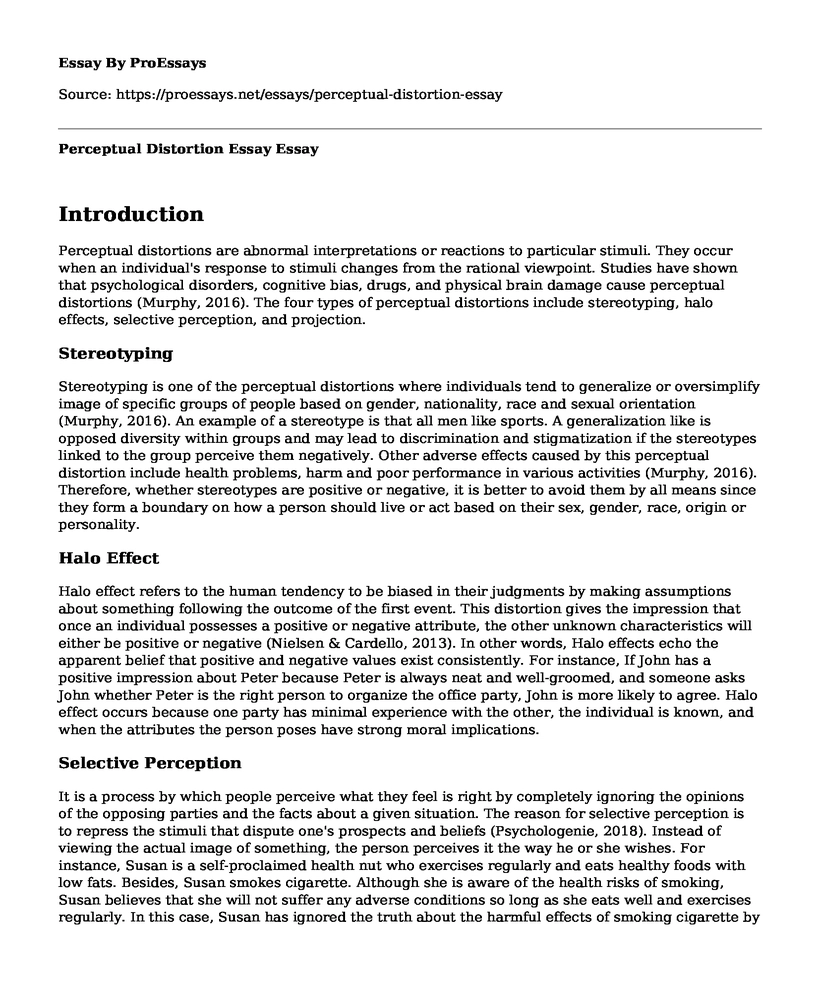Introduction
Perceptual distortions are abnormal interpretations or reactions to particular stimuli. They occur when an individual's response to stimuli changes from the rational viewpoint. Studies have shown that psychological disorders, cognitive bias, drugs, and physical brain damage cause perceptual distortions (Murphy, 2016). The four types of perceptual distortions include stereotyping, halo effects, selective perception, and projection.
Stereotyping
Stereotyping is one of the perceptual distortions where individuals tend to generalize or oversimplify image of specific groups of people based on gender, nationality, race and sexual orientation (Murphy, 2016). An example of a stereotype is that all men like sports. A generalization like is opposed diversity within groups and may lead to discrimination and stigmatization if the stereotypes linked to the group perceive them negatively. Other adverse effects caused by this perceptual distortion include health problems, harm and poor performance in various activities (Murphy, 2016). Therefore, whether stereotypes are positive or negative, it is better to avoid them by all means since they form a boundary on how a person should live or act based on their sex, gender, race, origin or personality.
Halo Effect
Halo effect refers to the human tendency to be biased in their judgments by making assumptions about something following the outcome of the first event. This distortion gives the impression that once an individual possesses a positive or negative attribute, the other unknown characteristics will either be positive or negative (Nielsen & Cardello, 2013). In other words, Halo effects echo the apparent belief that positive and negative values exist consistently. For instance, If John has a positive impression about Peter because Peter is always neat and well-groomed, and someone asks John whether Peter is the right person to organize the office party, John is more likely to agree. Halo effect occurs because one party has minimal experience with the other, the individual is known, and when the attributes the person poses have strong moral implications.
Selective Perception
It is a process by which people perceive what they feel is right by completely ignoring the opinions of the opposing parties and the facts about a given situation. The reason for selective perception is to repress the stimuli that dispute one's prospects and beliefs (Psychologenie, 2018). Instead of viewing the actual image of something, the person perceives it the way he or she wishes. For instance, Susan is a self-proclaimed health nut who exercises regularly and eats healthy foods with low fats. Besides, Susan smokes cigarette. Although she is aware of the health risks of smoking, Susan believes that she will not suffer any adverse conditions so long as she eats well and exercises regularly. In this case, Susan has ignored the truth about the harmful effects of smoking cigarette by believing in what she thinks is right.
Projection
Projection is a defense mechanism where one party displaces their unwanted feelings to another person instead of handling the unwanted feelings. People employ this perceptual distortion to cope with painful emotions (Everyday health). A common form of projection occurs when a person accuses someone of entertaining hostile thoughts because of his angry feelings. For instance, Juliet starts to dislike her sister-in-law Clara for being very close to her husband. Juliet knows that she must be friendly to Clara for the sake of her husband. However, after sometimes, Juliet starts to realize that Clara also resents her. Every time there is a family meeting, Juliet notices that Clara is rude to her particular when Juliet's husband is in the house. Juliet explains to her husband that she dislikes Clara because Clara also hates her. In this scenario, Juliet has projected her hatred for Clara.
References
Psychologenie. (2018, February 4th). Retrieved August 29th, 2018, from https://psychologenie.com/selective-perception
Everyday Health. (n.d.). Retrieved August 29th, 2018, from https://www.everydayhealth.com/emotional-health/psychological-projection-dealing-with-undesirable-emotions/
Murphy, P. (2016, June 9th). Psychology Today. Retrieved August 29th, 2018, from https://www.psychologytoday.com/us/articles/199805/where-bias-begins-the-truth-about-stereotypes
Nielsen, N., & Cardello, J. (2013, November 9th). Nielsen Norman Group. Retrieved August 29th, 2018, from https://www.nngroup.com/articles/halo-effect/
Cite this page
Perceptual Distortion Essay. (2022, Jul 25). Retrieved from https://proessays.net/essays/perceptual-distortion-essay
If you are the original author of this essay and no longer wish to have it published on the ProEssays website, please click below to request its removal:
- Research Paper on Dependence Between the Budget and Immigration in US
- Essay Sample on Women Education: Traditional to Modern
- Essay Sample on Safeguarding Tendencies: Adler's Neurotic Lifestyle
- Paper Example on Environment: Key to Enhancing Mood, Interaction, and Emotion
- Free Essay Example on Social Media Addiction: Impact on Mental Health & Habits
- Walter Reed Psychological Center: Multidisciplinary Behavioral Health Care in San Diego - Report Example
- The Right Age for Drinking or Smoking Onset - Essay Sample







